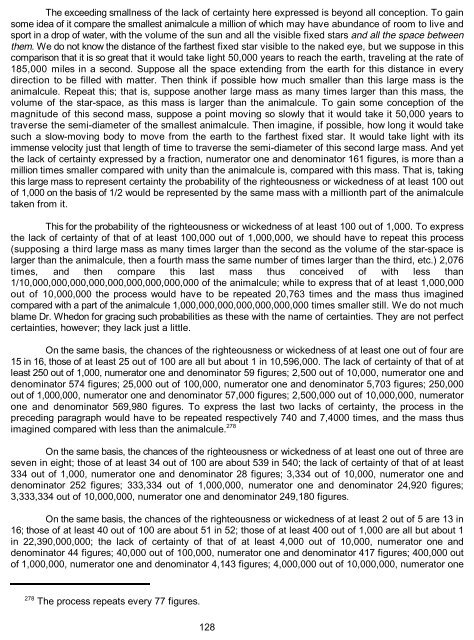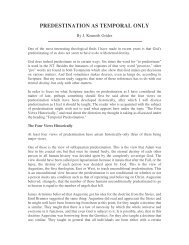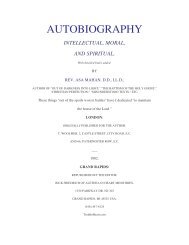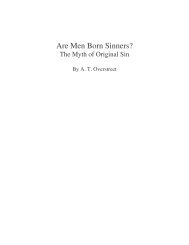The exceeding smallness <strong>of</strong> the lack <strong>of</strong> certainty here expressed is beyond all conception. To gain some idea <strong>of</strong> it compare the smallest animalcule a million <strong>of</strong> which may have abundance <strong>of</strong> room to live and sport in a drop <strong>of</strong> water, with the volume <strong>of</strong> the sun and all the visible fixed stars and all the space between them. We do not know the distance <strong>of</strong> the farthest fixed star visible to the naked eye, but we suppose in this comparison that it is so great that it would take light 50,000 years to reach the earth, traveling at the rate <strong>of</strong> 185,000 miles in a second. Suppose all the space extending from the earth for this distance in every direction to be filled with matter. Then think if possible how much smaller than this large mass is the animalcule. Repeat this; that is, suppose another large mass as many times larger than this mass, the volume <strong>of</strong> the star-space, as this mass is larger than the animalcule. To gain some conception <strong>of</strong> the magnitude <strong>of</strong> this second mass, suppose a point moving so slowly that it would take it 50,000 years to traverse the semi-diameter <strong>of</strong> the smallest animalcule. Then imagine, if possible, how long it would take such a slow-moving body to move from the earth to the farthest fixed star. It would take light with its immense velocity just that length <strong>of</strong> time to traverse the semi-diameter <strong>of</strong> this second large mass. And yet the lack <strong>of</strong> certainty expressed <strong>by</strong> a fraction, numerator one and denominator 161 figures, is more than a million times smaller compared with unity than the animalcule is, compared with this mass. That is, taking this large mass to represent certainty the probability <strong>of</strong> the righteousness or wickedness <strong>of</strong> at least 100 out <strong>of</strong> 1,000 on the basis <strong>of</strong> 1/2 would be represented <strong>by</strong> the same mass with a millionth part <strong>of</strong> the animalcule taken from it. This for the probability <strong>of</strong> the righteousness or wickedness <strong>of</strong> at least 100 out <strong>of</strong> 1,000. To express the lack <strong>of</strong> certainty <strong>of</strong> that <strong>of</strong> at least 100,000 out <strong>of</strong> 1,000,000, we should have to repeat this process (supposing a third large mass as many times larger than the second as the volume <strong>of</strong> the star-space is larger than the animalcule, then a fourth mass the same number <strong>of</strong> times larger than the third, etc.) 2,076 times, and then compare this last mass thus conceived <strong>of</strong> with less than 1/10,000,000,000,000,000,000,000,000,000 <strong>of</strong> the animalcule; while to express that <strong>of</strong> at least 1,000,000 out <strong>of</strong> 10,000,000 the process would have to be repeated 20,763 times and the mass thus imagined compared with a part <strong>of</strong> the animalcule 1,000,000,000,000,000,000,000 times smaller still. We do not much blame Dr. Whedon for gracing such probabilities as these with the name <strong>of</strong> certainties. They are not perfect certainties, however; they lack just a little. On the same basis, the chances <strong>of</strong> the righteousness or wickedness <strong>of</strong> at least one out <strong>of</strong> four are 15 in 16, those <strong>of</strong> at least 25 out <strong>of</strong> 100 are all but about 1 in 10,596,000. The lack <strong>of</strong> certainty <strong>of</strong> that <strong>of</strong> at least 250 out <strong>of</strong> 1,000, numerator one and denominator 59 figures; 2,500 out <strong>of</strong> 10,000, numerator one and denominator 574 figures; 25,000 out <strong>of</strong> 100,000, numerator one and denominator 5,703 figures; 250,000 out <strong>of</strong> 1,000,000, numerator one and denominator 57,000 figures; 2,500,000 out <strong>of</strong> 10,000,000, numerator one and denominator 569,980 figures. To express the last two lacks <strong>of</strong> certainty, the process in the preceding paragraph would have to be repeated respectively 740 and 7,4000 times, and the mass thus imagined compared with less than the animalcule. 278 On the same basis, the chances <strong>of</strong> the righteousness or wickedness <strong>of</strong> at least one out <strong>of</strong> three are seven in eight; those <strong>of</strong> at least 34 out <strong>of</strong> 100 are about 539 in 540; the lack <strong>of</strong> certainty <strong>of</strong> that <strong>of</strong> at least 334 out <strong>of</strong> 1,000, numerator one and denominator 28 figures; 3,334 out <strong>of</strong> 10,000, numerator one and denominator 252 figures; 333,334 out <strong>of</strong> 1,000,000, numerator one and denominator 24,920 figures; 3,333,334 out <strong>of</strong> 10,000,000, numerator one and denominator 249,180 figures. On the same basis, the chances <strong>of</strong> the righteousness or wickedness <strong>of</strong> at least 2 out <strong>of</strong> 5 are 13 in 16; those <strong>of</strong> at least 40 out <strong>of</strong> 100 are about 51 in 52; those <strong>of</strong> at least 400 out <strong>of</strong> 1,000 are all but about 1 in 22,390,000,000; the lack <strong>of</strong> certainty <strong>of</strong> that <strong>of</strong> at least 4,000 out <strong>of</strong> 10,000, numerator one and denominator 44 figures; 40,000 out <strong>of</strong> 100,000, numerator one and denominator 417 figures; 400,000 out <strong>of</strong> 1,000,000, numerator one and denominator 4,143 figures; 4,000,000 out <strong>of</strong> 10,000,000, numerator one 278 The process repeats every 77 figures. 128
and denominator 41,410 figures. We now reckon on the basis <strong>of</strong> 1/6. On this basis, the chances <strong>of</strong> the wickedness <strong>of</strong> at least five out <strong>of</strong> six are 34,375 in 46,656; the probability <strong>of</strong> that <strong>of</strong> at least 500,000 out <strong>of</strong> 600,000, or 5,000,000 out <strong>of</strong> 6,000,000 is a little more than 1/2. On the same basis, the chances <strong>of</strong> the wickedness <strong>of</strong> at least one out <strong>of</strong> two, are 35 in 36; those <strong>of</strong> at least 50 in 100 are all but 2,166,683,747,317,542,957,994,973,785,163,- 181,815,868,498,104,339,340,084,196,184,876 in 653,318,623,500,070,906,096,690,267,194,- 619,404,937,773,470,472,954,871,543,071,966,369,497,141,477,376, or about 1 in 300,000,000,000,000; the lack <strong>of</strong> certainty <strong>of</strong> that <strong>of</strong> at least 500 out <strong>of</strong> 1,000, numerator one and denominator 130 figures; 5,000 out <strong>of</strong> 10,000, numerator one and denominator 1,283 figures; 50,000 out <strong>of</strong> 100,000, numerator one and denominator 12,812 figures; 500,000 out <strong>of</strong> 1,000,000, numerator one and denominator 127,985 figures; 5,000,000 out <strong>of</strong> 10,000,000, numerator one and denominator 1,279,830 figures. On the same basis, the chances <strong>of</strong> the wickedness <strong>of</strong> at least 3 out <strong>of</strong> 4 are 1,125 in 1,296; those <strong>of</strong> at least 75 out <strong>of</strong> 100 are about 80 in 81; those <strong>of</strong> at least 750 out <strong>of</strong> 1,000 are all but about 1 in more than 1,350,000,0000,000; the lack <strong>of</strong> certainty <strong>of</strong> that <strong>of</strong> at least 7,500 out <strong>of</strong> 10,000, numerator one and denominator 101 figures; 75,000 out <strong>of</strong> 100,000, numerator one and denominator 989 figures; 750,000 out <strong>of</strong> 1,000,000, numerator one and denominator 9,860 figures; 7,500,000 out <strong>of</strong> 10,000,000, numerator one and denominator 98,500 figures. We now reckon on the basis <strong>of</strong> 1/4. On this basis, the chances <strong>of</strong> the wickedness <strong>of</strong> at least 2 out <strong>of</strong> 3 are 27 in 32; those <strong>of</strong> at least 67 out <strong>of</strong> 100 are about 32 in 33; those <strong>of</strong> at least 667 out <strong>of</strong> 1,000 are all but one in more than 14,000,000,000; the lack <strong>of</strong> certainty <strong>of</strong> that <strong>of</strong> at least 6,667 out <strong>of</strong> 10,000, numerator one and denominator 83 figures; 66,667 out <strong>of</strong> 100,000, numerator one and denominator 800 figures; 666,667 out <strong>of</strong> 1,000,000, numerator one and denominator 7,965 figures; 6,666,667 out <strong>of</strong> 10,000,000, numerator one and denominator 79,500 figures. Let us now reckon on the basis <strong>of</strong> 1/3. On this basis, the chances <strong>of</strong> the wickedness <strong>of</strong> at least one out <strong>of</strong> two are 8 in 9; those <strong>of</strong> at least 50 out <strong>of</strong> 100 are all but one in about 4,905; the lack <strong>of</strong> certainty <strong>of</strong> that <strong>of</strong> at least 500 out <strong>of</strong> 1,000, numerator one and denominator 28 figures; 5,000 out <strong>of</strong> 10,000, numerator one and denominator 262 figures; 50,000 out <strong>of</strong> 100,000, numerator one and denominator 2,596 figures; 500,000 out <strong>of</strong> 1,000,000, numerator one and denominator 25,930 figures; 5,000,000 out <strong>of</strong> 10,000,000, numerator one and denominator 259,200 figures. These calculations show how very great in a large nation is the probability <strong>of</strong> the wickedness <strong>of</strong> a considerable proportion <strong>of</strong> the inhabitants, based on the supposition that the average probability <strong>of</strong> the wickedness <strong>of</strong> each individual is from 1/2 to 5/6. They have reference, <strong>of</strong> course, to general wickedness; that is, to any wickedness which will cause the loss <strong>of</strong> the soul. the probability <strong>of</strong> the commission <strong>of</strong> wickedness <strong>of</strong> some kind is assumed to vary from 1/2 to 5/6 for each individual. But the probability <strong>of</strong> the commission <strong>of</strong> wickedness <strong>of</strong> some special kind is not so great. We have, therefore, one more calculation to make; viz., the probability <strong>of</strong> the commission <strong>of</strong> a special sort <strong>of</strong> wickedness <strong>by</strong> a certain proportion <strong>of</strong> the people. We have seen that voluntary actions are under God's control, that some are <strong>of</strong> such a nature that he, without departing from his regular plans <strong>of</strong> operation, can cause them to be the result <strong>of</strong> any volition, good or bad, Others, however, are <strong>of</strong> a different nature. They must, <strong>by</strong> the ordinary workings <strong>of</strong> God's providence and under certain circumstances, be the result <strong>of</strong> some sinful volition. Others, again, may be still more restricted, so that they can be the result only <strong>of</strong> certain kinds <strong>of</strong> sinful volitions. The probability <strong>of</strong> the performance <strong>of</strong> such voluntary actions <strong>by</strong> any individual is, <strong>of</strong> course, much smaller than that <strong>of</strong> general wickedness. We shall assume that the probability <strong>of</strong> any man's performing some such action is 1/100; this is certainly low enough. Let us reckon, then, on this basis. On this basis, the chances <strong>of</strong> the performance 129
- Page 1 and 2:
THE FOREKNOWLEDGE OF GOD 1 or, THE
- Page 3 and 4:
PREFACE I am not entirely pleased w
- Page 5 and 6:
Bayle, "is to cause it, if he can,
- Page 7 and 8:
imply no contradiction. Hence it is
- Page 9 and 10:
3 Theodicy, p. 198. FAILURE OF DR.
- Page 11 and 12:
harmonies of sound. Moral agency, i
- Page 13 and 14:
constituted the reason why he, for
- Page 15 and 16:
heaven," as well as the angels; yet
- Page 17 and 18:
One point more from Dr. Bledsoe. He
- Page 19 and 20:
power not to perform. As a free act
- Page 21 and 22:
of the soul." But to return. A free
- Page 23 and 24:
33 President Edwards. 34 35 consequ
- Page 25 and 26:
But experience may show a class of
- Page 27 and 28:
41 Will, Part II., Chapter II., P.
- Page 29 and 30:
"SECONDLY. If a power of Will deter
- Page 31 and 32:
"MOTIVE is usually considered as a
- Page 33 and 34:
62 it suits best to gratify the vil
- Page 35 and 36:
is especially evident when, as is v
- Page 37 and 38:
70 by the flavor, may be considered
- Page 39 and 40:
to gratify, the subjective motive.
- Page 41 and 42:
of choice. The former being a quali
- Page 43 and 44:
In the preceding paragraphs I have
- Page 45 and 46:
Mr. Webster also gives as one defin
- Page 47 and 48:
97 Will, Part I., Section II., p. 5
- Page 49 and 50:
105 Will, Part I, Section IV., p. 1
- Page 51 and 52:
But is this all? Is a mere thought
- Page 53 and 54:
in preference to both the sense of
- Page 55 and 56:
contend for in the case of man is t
- Page 57 and 58:
happen otherwise. This is not the t
- Page 59 and 60:
133 of such events he has and can h
- Page 61 and 62:
On page 9 of the Inquiry he says, "
- Page 63 and 64:
is indissoluble--that there cannot
- Page 65 and 66:
is evident from the fact that, the
- Page 67 and 68:
CHAPTER VII: OMNISCIENCE DOES NOT F
- Page 69 and 70:
It is easy to prove that whatever w
- Page 71 and 72:
its agent cannot refuse to act it.
- Page 73 and 74:
It would not conflict with any noti
- Page 75 and 76:
that they are certainly future, or
- Page 77 and 78: destroys all the force of the exhor
- Page 79 and 80: for the Master's use. And we admit,
- Page 81 and 82: 190 Institutes, Part II., Chapter V
- Page 83 and 84: the Scripture says of God's immutab
- Page 85 and 86: eginning of the condition of things
- Page 87 and 88: are sojourners of the Dispersion in
- Page 89 and 90: emotion, and constitute the princip
- Page 91 and 92: In the first place, this doctrine i
- Page 93 and 94: either prove God's necessitation of
- Page 95 and 96: the choice, every possible result o
- Page 97 and 98: 218 Will, Part II., Section XI., p.
- Page 99 and 100: To this we reply, 1. The destructio
- Page 101 and 102: PREDICTIONS FOLLOWING THE FREE VOLI
- Page 103 and 104: he caused, permitted, or predicted,
- Page 105 and 106: clearly indorses the doctrine that
- Page 107 and 108: passions to bear fruit to David's p
- Page 109 and 110: spoken of Judas. 1. Psalm 41:9. "Mi
- Page 111 and 112: temporal, but as a spiritual power.
- Page 113 and 114: nothing is said about any one's bei
- Page 115 and 116: determined before to be done." 252
- Page 117 and 118: Deut. 32:21, compared with Rom. 9:1
- Page 119 and 120: 262 probability." In this sense of
- Page 121 and 122: no matter how many times it has bee
- Page 123 and 124: If depravity must be freely appropr
- Page 125 and 126: probable facts of the future. The p
- Page 127: his moral character changes, and as
- Page 131 and 132: Scriptures. but the signification o
- Page 133 and 134: such as the Israelites committed be
- Page 135 and 136: or foreknowing their free volitions
- Page 137 and 138: Christ and his righteousness, and t
- Page 139 and 140: (verse 34). The prophecy, then, was
- Page 141 and 142: 296 Epistle 2:18." He also says, "T
- Page 143 and 144: when they are so manifestly spoken
- Page 145 and 146: The Protestant world does not usual
- Page 147 and 148: any free volition was made by him,
- Page 149 and 150: it shall not prosper" verse 27. mi
- Page 151 and 152: Isaiah 2;2-4. "And it shall come to
- Page 153 and 154: Other evidence that he did not poss
- Page 155: From the same notion of God's ignor






